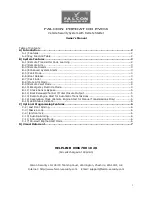
PI - 34.85
Product Information Linear Smoke Detector Fireray 50/100RV
601-F.01U.002.705
A1.en / 29.12.2004
ST-FIR/ PRM1/ zab
Seite 17 von 22
When the calibration procedure is complete, move the operating mode switch (see
Fig. 3.) to the bottom (if the detector is mounted vertically) or to the left (if the
detector is mounted horizontally). The detector is now in «Operating Mode».
The detector runs a calibration test for approx. 60 s. If the yellow LED lights up as
a steady light after the test, you must repeat the detector alignment and calibration
procedures (see Sections 8.1. and 8.2.).
If a detector alarm is reset in normal mode by a disruption to the power
supply, the detector automatically runs a calibration test. If the test is
failed, the detector remains in the alarm position. If the test is positive,
the yellow LED goes out, the fault relay is reset and the detector is
returned to normal mode.
In normal mode, the yellow LED flashes every 10 s.
8.3. System test
The «Alarm» and «Malfunction» functions must be checked before final start - up.
Alarm test
Hold the test filter in front of the receiver lens (upper or right- hand part of detector).
Select a volume of smoke slightly greater than the threshold set for the detector (see
Section 7.1.). Make sure that you do not also cover the transmitter -lens.
After approx. 10 s, the red LED must light up and the alarm relay must close.
With the «Save alarm» detector setting (DIP switch 1 «off»), there must be a reset
at the control panel or the power supply must be disrupted for at least 5 s.
With the setting «Auto Reset» setting (DIP switch 1 «on»), the alarm is reset
automatically if the volume of smoke falls below the selected alarm threshold for at
least 5 s.
Fault test
Cover the reflector with a non - reflective material.
After approx. 10 s, the yellow LED must light up and the fault relay must open. As
soon as the obstruction is removed, the detector returns to normal mode
automatically after approx. 2 s.






































